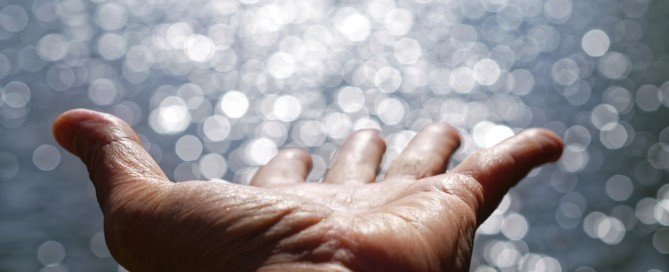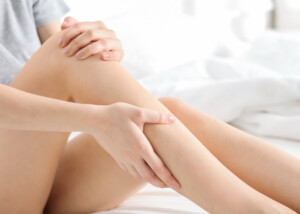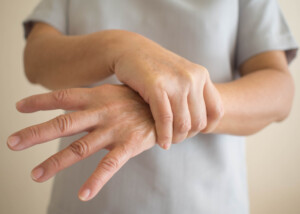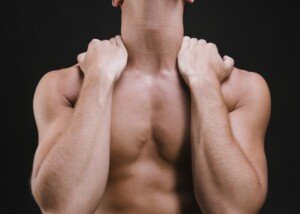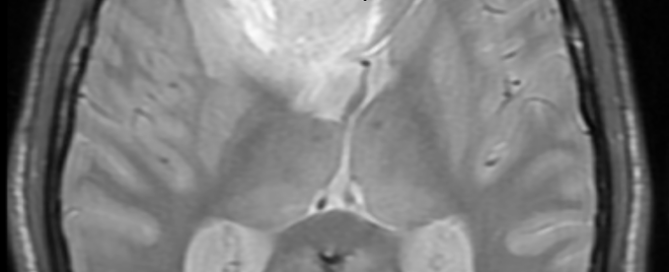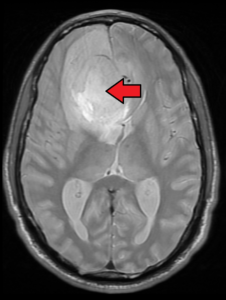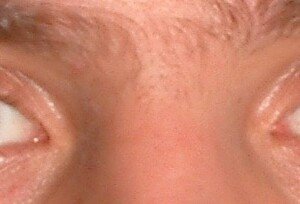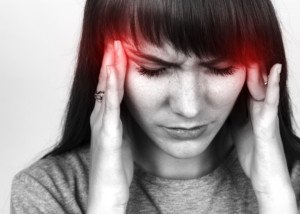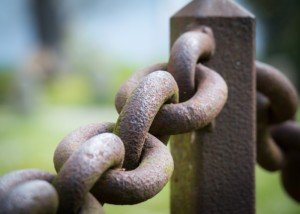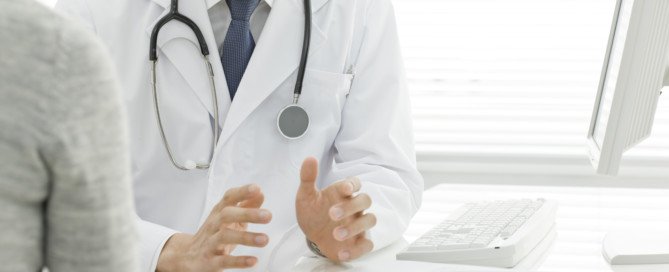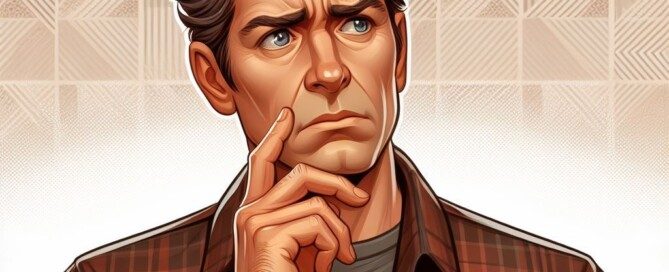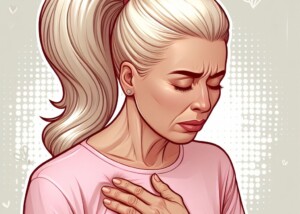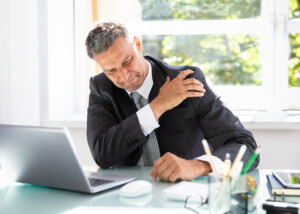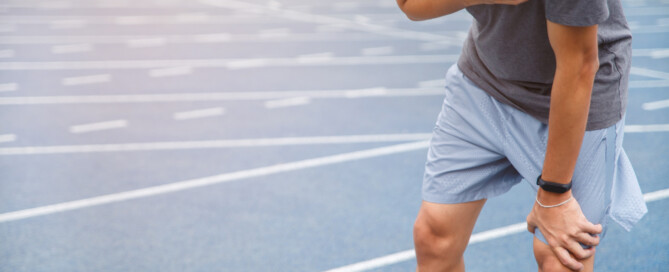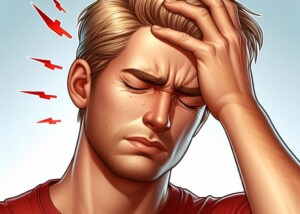Twitching Muscles: Fasciculations vs. Myokymia
What you think is a muscle twitch from MS (myokymia) may actually be just a harmless fasciculation; there’s a way to tell the difference with these two kinds of muscle twitching. (more…)
Can Multiple Sclerosis Start with a Twitching Nose?

There actually is a type of facial twitch that’s associated with multiple sclerosis.
Can a Brain Tumor Cause Eyelid Twitching?
A brain tumor can cause an eyelid to droop, but the big question is: Can a brain tumor cause an eyelid to twitch?
Many people who have a persistently twitching eyelid are terrified that this is being caused by a brain tumor.
“Eyelid twitching is very common and is usually benign, but can be serious in rare cases,” begins Kaushal M. Kulkarni, MD, board certified ophthalmologist and neuro-ophthalmologist in private practice in New York.
Usually, when an eyelid twitches, there’s something going on with the tiny muscles of the eyelid.
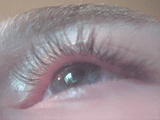
Credit: Leitz31337 at English Wikipedia
These very tiny muscles are contracting—and this is what you feel and see as the twitching (fasciculations).
Do not confuse a twitching eyelid with a drooping one.
There are many causes of the drooping, which is called ptosis. One is a brain tumor.
So you’re probably wondering, “If a brain tumor can cause an eyelid to droop, can it also cause the eyelid to twitch?”
Is the Twitching in just One Eyelid?
Dr. Kulkarni explains, “Intermittent eyelid twitching or fluttering in just one eyelid, which comes and goes, is very common and usually due to a benign condition called eyelid myokymia.”
Myokymia is the medical term for harmless muscle twitching on a very small scale.
“It is commonly brought on by stress, lack of sleep or caffeine,” says Dr. Kulkarni. Sometimes, an eyelid twitches for no real reason.
“However, if the twitching involves more than just the eyelid and involves the head, face, cheek, mouth or jaw, it needs to be evaluated by a doctor.”
Are BOTH Eyelids Twitching?
“If the twitching or spasm is in both eyes, this is usually a condition called blepharospasm,” says Dr. Kulkarni.
“This is a condition that causes intermittent spasm of both eyelids for reasons we do not completely understand.
“It is a benign condition, hence the name benign essential blepharospasm. It can usually be treated with Botox injections around the eye.
“In fact, this was one of the original uses for Botox. It was only after patients with blepharospasm who received Botox injections and noticed that their wrinkles disappeared that Botox became popularized and marketed as it is today!”
The thing about BOTH eyelids twitching (bilateral fasciculations) is that this is a very reassuring sign that the cause is not likely a brain tumor.
When a brain tumor affects the eye or surrounding structures, it is almost always just one eye – and the same eye at that.
Same side twitching but…are there also spasms of the nose, cheek, lip, chin, etc.?
This is called hemifacial spasm: one side of the face. Botox may be effective depending on cause.
“If there is an artery compressing the facial nerve, a neurosurgical procedure can sometimes relieve the spasm,” says Dr. Kulkarni.
Brain Tumor As Cause of Twitching Eyelid
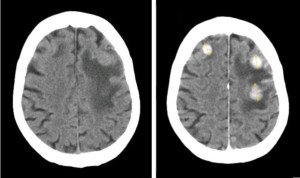
The three lit-up spots are three separate tumors. Jmarchn commons.wikimedia.orgwikiFileBrainMetastasisFromBreastCancer
“Anyone with hemifacial spasm needs to have a brain scan to check for a brain tumor compressing the facial nerve,” says Dr. Kulkarni.
This nerve is one of the cranial nerves that leads to the brain.
There is a type of brain tumor — a Schwannoma of the facial nerve in the cerebellopontine angle – that can cause an eyelid to twitch.
This brain tumor is rare – and benign. Plus, by the time it would ever cause eyelid fasciculations, it would certainly also be causing other symptoms such as hearing loss, tinnitus or dizziness.
Another tumor that affects the brain and can cause an eyelid to twitch is a meningioma (90 percent are benign).
However, a malignant tumor of the brain stem can cause eyelid twitching, and over time it will progress to hemifacial spasm.
In all fairness, it must also be mentioned that the worst brain tumor that an adult could have, the glioblastoma multiforme, is capable of causing a twitching eyelid.
The Journal of Neurosurgery (March 1962) notes the case of a man, 31, who had “loss of consciousness and dizzy spells associated with involuntary twitching of the right eyelid and right shoulder.”
However, this case report describes a very rare situation of a GBM spreading beyond the cranium. GBMs are rare enough as it is, with a diagnosis rate of two to three per 100,000.
Putting Things into Perspective
Eyelid twitching that originates from a brain tumor is extremely rare.
Furthermore, by the time the fasciculations arise, there will likely be other symptoms (e.g., other facial disturbances, vision issues, headache, vomiting, seizures, weakness).
Just rubbing an itching eyelid can make it flutter.
Relax, don’t panic over this extremely common condition that you’ve probably experienced many times during childhood and didn’t give it a second thought. Oh, to be a kid again!
Eye-Related Symptoms of Brain Tumor: Compilation from the Following Sites:
Webmd.com, cancer.net, mayoclinic.org, cancercenter.com, medlineplus.gov
• Changes in vision
• Partial or complete loss of vision
• Double vision
• Blurred vision
• Loss of peripheral vision
• Inability to look upward
• Drooping eyelid (ptosis)
• Pupils different size
• Uncontrollable eye movement
• Bulging eye
Non-Tumor Brain Causes of Eye Twitching from Mayoclinic.com
• Tourette syndrome
• Oromandibular dystonia, facial dystonia
• Multiple sclerosis
• Dystonia
• Cervical dystonia
• Bell’s palsy
These non-tumor brain conditions, however, almost always come with other symptoms alongside the twitching eyelid.
 Dr. Kulkarni specializes in providing refined medical and surgical eye care, and has a special interest in optic nerve regeneration. He completed subspecialty training in neuro-ophthalmology at the prestigious Bascom Palmer Eye Institute in Miami, FL.
Dr. Kulkarni specializes in providing refined medical and surgical eye care, and has a special interest in optic nerve regeneration. He completed subspecialty training in neuro-ophthalmology at the prestigious Bascom Palmer Eye Institute in Miami, FL.
 Lorra Garrick has been covering medical, fitness and cybersecurity topics for many years, having written thousands of articles for print magazines and websites, including as a ghostwriter. She’s also a former ACE-certified personal trainer.
Lorra Garrick has been covering medical, fitness and cybersecurity topics for many years, having written thousands of articles for print magazines and websites, including as a ghostwriter. She’s also a former ACE-certified personal trainer.
.
Top image: James Heilman, MD
Sources:
health.harvard.edu/diseases-and-conditions/drooping-eyelid-ptosis
mayoclinic.org/symptoms/eye-twitching/basics/causes/sym-20050838
webmd.com/cancer/brain-cancer/brain-tumors-in-adults
cancer.net/cancer-types/brain-tumor/symptoms-and-signs
mayoclinic.org/diseases-conditions/brain-tumor/symptoms-causes/dxc-20117134
cancercenter.com/brain-cancer/symptoms/
medlineplus.gov/ency/article/007222.htm
sciencedirect.com/science/article/pii/0090301989901845
search.proquest.com/openview/7e8d767009e75ab42ac28b58a29485d5/1?pq-origsite=gscholar&cbl=13886
thejns.org/doi/abs/10.3171/jns.1962.19.3.0186?journalCode=jns
aans.org/Patients/Neurosurgical-Conditions-and-Treatments/Glioblastoma-Multiforme
academic.oup.com/neurosurgery/article-abstract/7/4/363/2746762
Can a TIA Cause a Metal Taste in the Mouth?

Perhaps you’ve read that a stroke can cause a metal taste in the mouth, but this doesn’t necessarily mean that a TIA can leave a metal taste in your mouth, does it?
A TIA (transient ischemic attack) is a temporary stroke. Both a TIA and an ischemic stroke occur when a blood clot forms in a blood vessel in the brain.
The only difference between a TIA and a stroke is that the former dissolves, usually in just minutes, and the person’s symptoms disappear as quickly as they came on.
When people experience one of these “mini-strokes,” as they’re sometimes referred to, they will have a sudden-onset of one or more of the following symptoms:
• Paralysis on one side of the body
• One-sided numbness, tingling, heaviness and/or clumsiness
• The one-sided symptoms can occur to the face (e.g., one side of the mouth droops)
• Dizziness
• Vision problems: double, blurred, dimmed or what seems like a shade being pulled over one eye
• Loss of bowel or bladder control
• Unconsciousness is possible.
• Slurred speech
• Trouble forming words
• Trouble swallowing
• Difficulty understanding speech
• Cognitive impairment
If you’ve checked the TIA symptom lists from other reputable sites, you already know that “phantom metal taste” does not show up.
But does that mean it’s impossible for a transient ischemic attack to result in a brief perception of tasting metal?
“It is very unlikely that an isolated metallic taste would be associated with a TIA or stroke,” says Atif Zafar, MD, medical director of St. Michaels Hospital in Toronto, Ontario, and former director of the stroke program at University of New Mexico Hospital.
Dr. Zafar explains, “An insult to the pons or insula can be associated with altered taste, but these areas typically cause other symptoms like vision, balance or cognitive problems, along with altered taste or smell.
“Metallic tastes or a burning rubber smell can be associated with auras in patients with epilepsy.
“I have had various patients report smell or taste alteration before they went on to have a convulsive seizure.”
More on Stroke and Change in Taste
The permanent damage from a stroke can leave the patient with ongoing taste-related issues.
A TIA is actually a forerunner of a stroke; one-third of stroke victims had a previous transient ischemic attack.
And here’s a fair speculation: If a person suffers the sudden-onset symptoms of a TIA — such as suddenly one side of their face goes heavy and limp — and at that same time there’s a mechanism causing a metallic taste in their mouth — they may not be aware of this phantom taste.
Imagine that suddenly you can’t form words and one side of your face is paralyzed.
You’ll be focused (and terrified) over the paralysis and inability to form language — never mind how things inside your mouth taste.
However, a TIA can last a full hour, even a few hours, and during this time, it’s much easier to also then begin noticing that there’s an odd taste in the mouth.
Though “sudden-onset metallic taste” does not make the symptom lists for many major medical organizations, there is a very intriguing TIA symptom discription on the Mt. Sinai site.
The site says, “The symptoms of TIA are the same as the symptoms of a stroke, and include:”
And one of the bullet points is as follows:
Changes in the senses (such as hearing, vision, taste, and touch).
So there you have it: At a minimum, a TIA can cause “changes” in “taste.”
It’s logical to conclude that there’ve been patients who’ve described this taste as being like metal — but there’s no objective way to confirm this.
Steven Park, MD, an ear, nose and throat physician, explains every possible cause of a metal taste in the mouth.
Dr. Zafar is author of the book, “Why Doctors Need to Be Leaders.” His interests include vascular and endovascular neurology, and the neurosciences.
 Lorra Garrick has been covering medical, fitness and cybersecurity topics for many years, having written thousands of articles for print magazines and websites, including as a ghostwriter. She’s also a former ACE-certified personal trainer.
Lorra Garrick has been covering medical, fitness and cybersecurity topics for many years, having written thousands of articles for print magazines and websites, including as a ghostwriter. She’s also a former ACE-certified personal trainer.
.
Top image: Shutterstock/spetenfia
Sources:
stroke.org.uk/what-stroke/common-problems-after-stroke/changes-taste-and-smell
upmc.com/patients-visitors/education/Documents/StrokeEducationforPatientsandFamilies.pdf
mayoclinic.org/diseases-conditions/transient-ischemic-attack/basics/symptoms/con-20021291
clevelandclinic.org/health/articles/transient-ischemic-attack
Cause of Golden Yellow Poops

Is the cause of gold stools—a more golden color rather than straight yellow—different from the cause of a blander yellow type of poop?
What can be considered a “gold” stool might actually be a yellowish tan, or maybe even a very light brown.
The lighting in the bathroom stall will also influence how you see the color.
There’s really no such thing as a pure golden color for poops.
But if stools appear to be gold, they are probably what a doctor would consider to be yellow.
Yellow Stools: Cause for Worry?
“The color yellow is not concerning and can be affected by bile in the stool,” says Franjo Vladic, MD, a board certified gastroenterologist with Center for Digestive Health and Endoscopy Center in Ohio.
Dr. Vladic explains, “Color is hard to decipher, and pale or clay-colored (grey) stools can be interpreted as yellow, so it is worth bringing to the attention of a doctor who can determine whether further evaluation is merited.”
A good idea would be to collect your stools, next time they appear to be a golden yellow, and bring them into the office for your doctor to inspect.
Though this task will be unlike any that you’ve ever done, it’s a really important one to conduct, as follows:
Using a strainer that easily fits into the toilet bowl, carefully collect the BMs.
Allow the fluid to strain out, then place them in a plastic container, then tightly seal it.
The container should be refrigerated unless your doctor appointment is that same day.
Your doctor will be able to tell if your bowel movements ahave a yellow/gold tint or are actually more of a grey (which would be very concerning).
What can give a golden tint to your poops is the supplement turmeric or curcumin.
Some of the brilliant orange of this supplement will get passed and end up on stools.
When bile makes stools appear yellow, this is not a concern, as Dr. Vladic notes. Bile in stool is a normal process.
Colon Cancer
Colon cancer does not turn stools any shade that can pass as yellow or gold.
Colon cancer sometimes causes blood to get mixed with BMs, making them appear bloody, maroon or full of a black, tar-like substance (old blood).
You can do colon cancer screening at home with Cologuard — this is a simple stool collection kit that uses state-of-the-art DNA technology to identify cells that are abnormal in appearance.
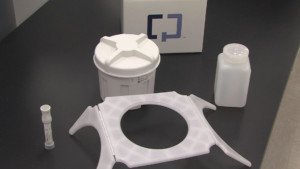
If abnormal cells are detected, your doctor will likely recommend a colonoscopy for diagnosis.
Serious conditions can turn bowel movements a pale color, but do not confuse pale or beige with yellow or golden.

Dr. Vladic’s special interests include acid reflux, colitis, colon cancer, GERD, heartburn, IBS, liver disease, obesity, pancreatitis and peptic ulcer, among many others.
 Lorra Garrick has been covering medical, fitness and cybersecurity topics for many years, having written thousands of articles for print magazines and websites, including as a ghostwriter. She’s also a former ACE-certified personal trainer.
Lorra Garrick has been covering medical, fitness and cybersecurity topics for many years, having written thousands of articles for print magazines and websites, including as a ghostwriter. She’s also a former ACE-certified personal trainer.
Left Arm Pain As an ONLY Symptom: Heart Related?
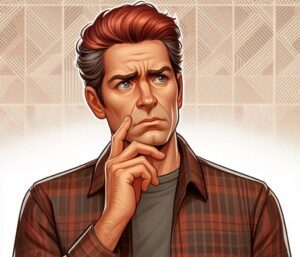
So you know that left arm pain with chest pain, nausea, sweating might mean a heart attack.
But what if your ONLY symptom is unexplained left arm pain?
First off, even when pain in the left arm is indeed accompanied by other concerning symptoms such as dizziness, cold clammy skin and/or shortness of breath, this doesn’t necessarily mean you’re having a heart attack – though it is highly suggestive of serious heart disease.
Even more difficult to speculate on is the cause of new-onset pain in the left arm when that’s your only symptom—and there’s no reason to believe it’s from an injury.
“There is no surefire way to know if this is cardiac or not,” says Dr. Kavitha Chinnaiyan, MD, a cardiologist at William Beaumont Hospital in Royal Oak, MI.
Dr. Chinnaiyan is founder of Heal Your Heart, Free Your Soul, an online, yoga-based prevention program.
Only One Symptom: Pain in the Left Arm – And You Haven’t Fallen on It or Strained It During Exercise
What should you do?
Dr. Chinnaiyan continues, “If one has risk factors for heart disease (diabetes, high blood pressure, high cholesterol, high stress and smoking, for instance), it is better to assume that it may be cardiac and get checked.
“Arm pain, tingling and numbness can also result from nerve compression in the upper part of the spine. Musculoskeletal problems can also cause these symptoms.”
Put Everything in Context
If you’re having left arm pain and no other symptoms, you need to put this in perspective.
• Did you recently bang the arm into a door frame?
• Did you recently fall on it during sport?
• Is it tender to the touch?
• Does it hurt more with certain movements? These first four issues point away from heart trouble and towards a musculoskeletal problem.
• Is its entire length very swollen? This can mean a blood clot in the neck.
• Does physical exertion that EXCLUDES the arm bring on the pain?
For example, it usually begins hurting when you run, walk up a flight of stairs, pedal a stationary bike, but subsides when you stop? (suspicious for heart trouble)
• Does the pain occur only when you’re at rest and doesn’t change with movement, and there’s no history of injury? (suspicious for heart trouble)
• Is the pain very short in duration (seconds) and has been coming and going throughout the day? (unlikely to be heart related)
• Has the discomfort been ongoing for weeks or even days? (unlikely to be heart related)
• Was the hurting present upon getting out of bed in the morning, suggesting that you slept on it funny?
• Is it aggravated with neck movement? This suggests a problem with the cervical vertebrae.
• Does shoulder movement aggravate it? Arthritis can cause this.
If you have risk factors for heart attack or even coronary artery disease, and you’ve been experiencing just one unexplained symptom lately—left arm pain—the first doctor you should see is a cardiologist.

Dr. Chinnaiyan has authored and co-authored 100+ manuscripts and abstracts. She has served as the Chair of the Board of Directors of the American Heart Association of Southeast Michigan.
 Lorra Garrick has been covering medical, fitness and cybersecurity topics for many years, having written thousands of articles for print magazines and websites, including as a ghostwriter. She’s also a former ACE-certified personal trainer.
Lorra Garrick has been covering medical, fitness and cybersecurity topics for many years, having written thousands of articles for print magazines and websites, including as a ghostwriter. She’s also a former ACE-certified personal trainer.
.
Top image: ©Lorra Garrick
sscpywrt26
Chest Pain Upon Waking, Gets Better Soon After

You should not rule out a heart problem if you keep awakening with chest pain that gets better soon afterwards.
It may seem odd that a heart problem would cause chest pain only in the morning, but this is no reason to shrug off this symptom. (more…)
Can Chest Pain with Burping Mean a Heart Problem?
If you have burping along with your chest pain, this definitely can mean something’s going on with your heart.
A visit to a cardiologist would be smart.
Angina Chest Pain with Burping
Angina is impaired blood flow to the heart caused by blockages in the coronary arteries.
When someone has an anginal episode, it can also come with dizziness, nausea and…burping.
“This has nothing to do with what’s going on inside the heart,” explains Dr. Kavitha Chinnaiyan, MD, a cardiologist at William Beaumont Hospital in Royal Oak, MI.
Dr. Chinnaiyan is founder of Heal Your Heart, Free Your Soul, an online, yoga-based prevention program.
“It has more to do with associated symptoms arising from irritation of surrounding structures such as the esophagus and diaphragm.”
In short, the heart doesn’t burp. Instead, the problem that’s occurring with the heart is affecting other structures that lead to burping.
When the Belching Occurs
Chest pain from stable angina occurs during physical exertion (which can be as innocuous as going up a staircase) and/or during anger.
If burping is tied to the anginal condition, it, too, will occur during these triggers.
This is not the burping that occurs after finishing a meal or gulping in air while drinking soda.
If burping, then, occurs only during physical exertion or angry emotions, and especially if it’s accompanied by chest pain, the first doctor you should see is a cardiologist.
The duo of belching with chest pain isn’t always caused by a heart problem, though.
But a strong suggestion that burping with chest pain is heart related is that these symptoms occur only during physical effort and/or intense anger – and they disappear when the trigger is removed.
How does a heart problem cause burping?
Impeded blood flow in the heart stimulates the vagal nerve, causing stomach distress, leading to gas formation.
Causes of Chest Pain with Burping that Are NOT Heart Related
1 Irritable bowel syndrome
2 Peptic ulcer
3 Acid reflux (GERD)
4 Hiatal hernia
5 Pancreatitis
You’ll notice with these other conditions that certainly, additional symptoms would be present that are not indicative of a heart problem.
For example, IBS comes with recurring diarrhea, constipation or both.
A hiatal hernia can come with bloody stools.
Pancreatitis comes with oily smelly stools that float, and weight loss.
If you’ve been experiencing undiagnosed chest pain that’s accompanied by burping…don’t ignore this.

Dr. Chinnaiyan has authored and co-authored 100+ manuscripts and abstracts. She has served as the Chair of the Board of Directors of the American Heart Association of Southeast Michigan.
 Lorra Garrick has been covering medical, fitness and cybersecurity topics for many years, having written thousands of articles for print magazines and websites, including as a ghostwriter. She’s also a former ACE-certified personal trainer.
Lorra Garrick has been covering medical, fitness and cybersecurity topics for many years, having written thousands of articles for print magazines and websites, including as a ghostwriter. She’s also a former ACE-certified personal trainer.
Top image: Freepik/KamranAydinov
Sources:
ncbi.nlm.nih.gov/pmc/articles/PMC3074882/
newhealthadvisor.com/Burping-and-Chest-Pain.html
Chest Pain Only After Exercising, Not During?

If you’re having chest pain AFTER exercise, not during the activity, this may still be related to your heart.
The older you are, the more likely that any chest pain that’s associated with exercise is due to a heart problem. (more…)
TIA Headache vs. Ruptured Brain Aneurysm Headache


